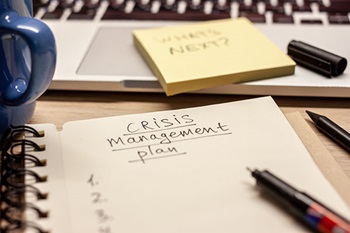A Crisis Hits: Are You Ready?
A major food safety outbreak has occurred, your product has been recalled, or some other crisis situation has happened.

How do you recover? Using effective communications and crisis management strategies and tactics can mitigate the crisis’s potential effects on your organization and, in many cases, help your company survive.
A crisis is any unusual event or situation that could lead to claims against a company, a severe loss of stakeholder confidence, and/or unexpected disruption of business operations. Similar to recalls, crises are tiered based on severity:
- Tier 1: Critical, potential irreparable effects on a company’s ability to operate in the future
- Tier 2: Possible significant ramifications for reputation, but less impact on company operations
- Tier 3: Inconvenient for company, low potential for immediate, lasting reputational damage
If not handled effectively, a tier three crisis can quickly escalate to a tier two or even one. Therefore, quick, appropriate action and careful attention to the situation, is critical.
While a crisis may expose vulnerabilities and reveal organizational challenges to a company’s stakeholders, it is possible to recover and recover fully. Whether you’re a supplier, manufacturer or packaging facility, it’s important to prepare for the worst because the window for influencing perceptions is small, so you would have to act fast.
A four-step, systematic approach will help your company face complex crises when they hit, allowing you to appropriately assess and frame a crisis situation:
Step One: Analysis
Analyze and assess your company’s vulnerabilities exposed by the crisis situation. Measure risk and imagine the worst-case scenarios that could possibly develop. Once the scope of the crisis has been identified, a designated crisis team should gather senior executives and leaders to establish individual responsibilities and make quick and binding decisions for the company. This team should be the people needed and empowered to make necessary decisions and take immediate action. Lengthy approval processes will kill a company in a crisis, as time is of the essence.
Next, assess and identify the key audiences affected by the crisis. This includes any group of individuals, such as employees, customers, investors, partners, competitors, influencers and the media that would be impacted by the situation. Audience identification will guide how you communicate, on which channels, and what needs to be said to each audience.
Step Two: Preparation
Think through the potential ways each key audience may be affected, what information they need to know and how to best communicate news to each audience.
Develop a plan that includes:
- How to get the information to the audiences who matter
- What audiences need to hear and what does the company need to tell them
- Who will deliver the news
- How the company will receive and answer questions and/or media inquiries
Create talking points that help guide a spokesperson on what to say so that he or she shares the news while staying on message—saying only what you want said but in a way that will resonate. Talking points could be different per audience, depending on their needs. Next, develop a Q&A, an internal document used to guide the organization’s spokesperson who will help him or her answer any possible questions and remain on-message. Brainstorm all potential questions, and always frame answers in a positive light while being transparent and informative. Both talking points and Q&A documents help to align a company’s response.
You may need to develop additional communications materials based on audience needs and/or the severity and type of situation. For instance, if company partners are used to hearing from the company through emails from the CEO, you would want to continue to use that communications channel to ensure consistency from that audience’s perspective. If you have to register the crisis with a regulatory body, that would require a notice dependent on the agency. If you need the information to be widely known quickly, writing a press release and distributing it to media may be the way to go.
The bottom line is to always communicate with your audiences where they are. Don’t make them come looking for information from you. Talk to them how they’re used to hearing from you (i.e. email, phone call) and prepare the materials you will need to do so.
Step Three: Response
Activate on your plan, and do it quickly. If possible, be the first to share the crisis and take ownership of the situation to shape the audiences’ perception and own the developing story.
If you can’t be ready quickly enough with all the communications materials to best convey your message to you key audiences or if you still need time to assess the full extent of the situation, releasing a holding statement may be necessary. A holding statement gives as much information as you are certain of at the time, and says you will communicate more as you have more information. It holds off questions until you’re ready to answer them.
All statements should be transparent, informative and released quickly.
Step Four: Recovery
Provide regular updates and statements to the public and your organization’s stakeholders. Represent the organization’s active involvement in addressing and monitoring the situation while working to reduce the crisis lifespan.
Crisis management is a team effort. An organization is more equipped to handle a crisis situation when it’s directed by strategic planning and effective internal and external communication. Remember, it’s not over until it’s over—crisis management may require ongoing changes within your organization.
Take the time to re-evaluate situations after a few months and make changes accordingly.
Be Ready
If your company does not already have one, consider developing a crisis plan that includes both communications and operations instructions for what to do when the unthinkable—or horribly inconvenient—happens. It will take time to put a plan like this together, but it will be worth it at the end.
By Kristin Brown, SVP at Racepoint Global
Kristin Brown is a senior vice president at Racepoint Global. She led an interactive crisis management workshop at the 2018 SQF International Conference on how to manage and facilitate a crisis situation. Kristin can be reached at kbrown@racepointglobal.com.
Recent Blog Posts
The FMI Foundation, in partnership with SQFI, awarded 19 scholarships from 152 applications for the 2025-2026 Food Safety Auditing Scholarship program.
Private brands in the grocery industry are experiencing significant growth, evolving from budget alternatives to strategic assets that drive customer loyalty and distinguish retailers.
Recall prevention means embedding food safety throughout your operations so those failures never reach the customer.




